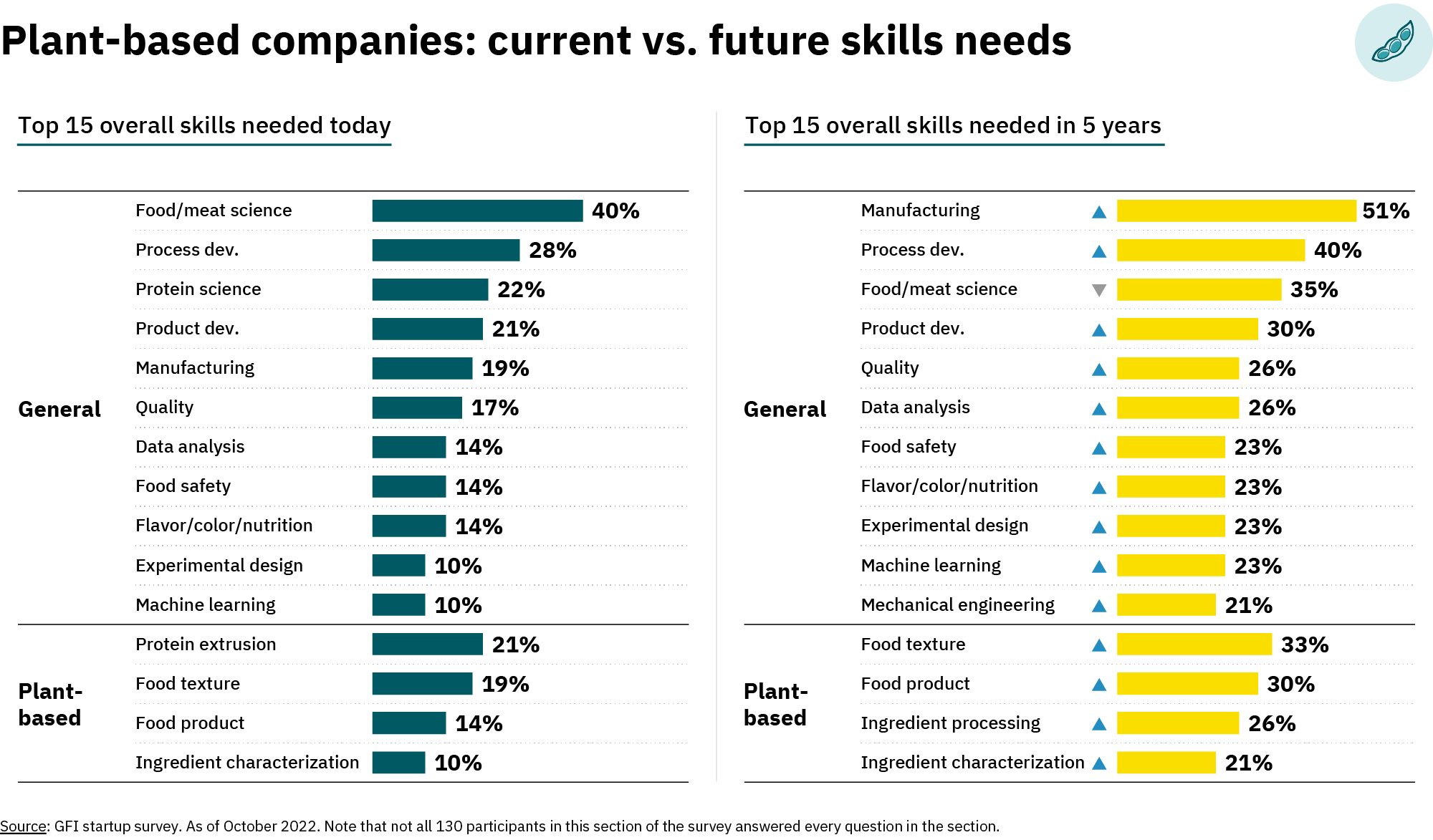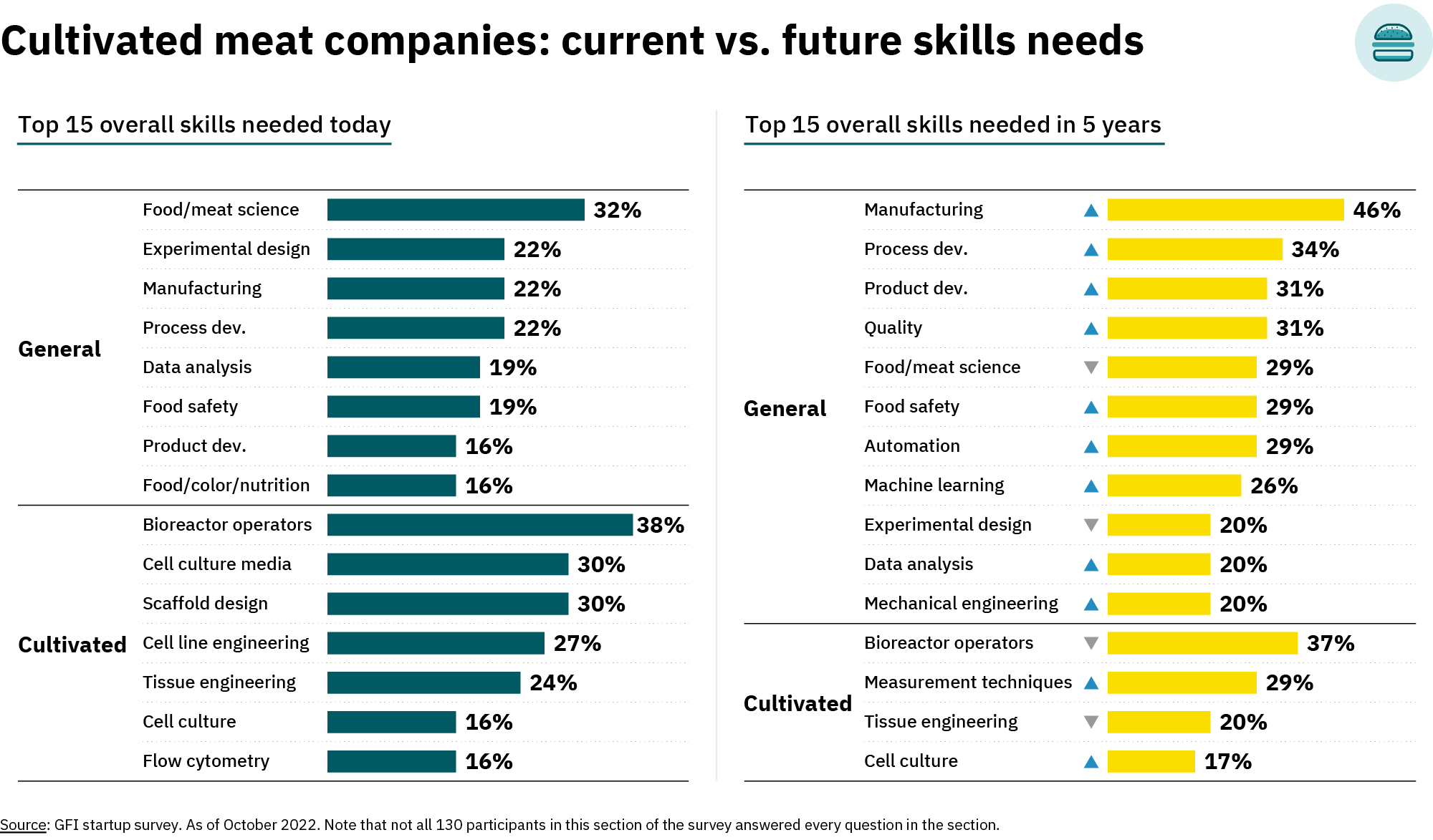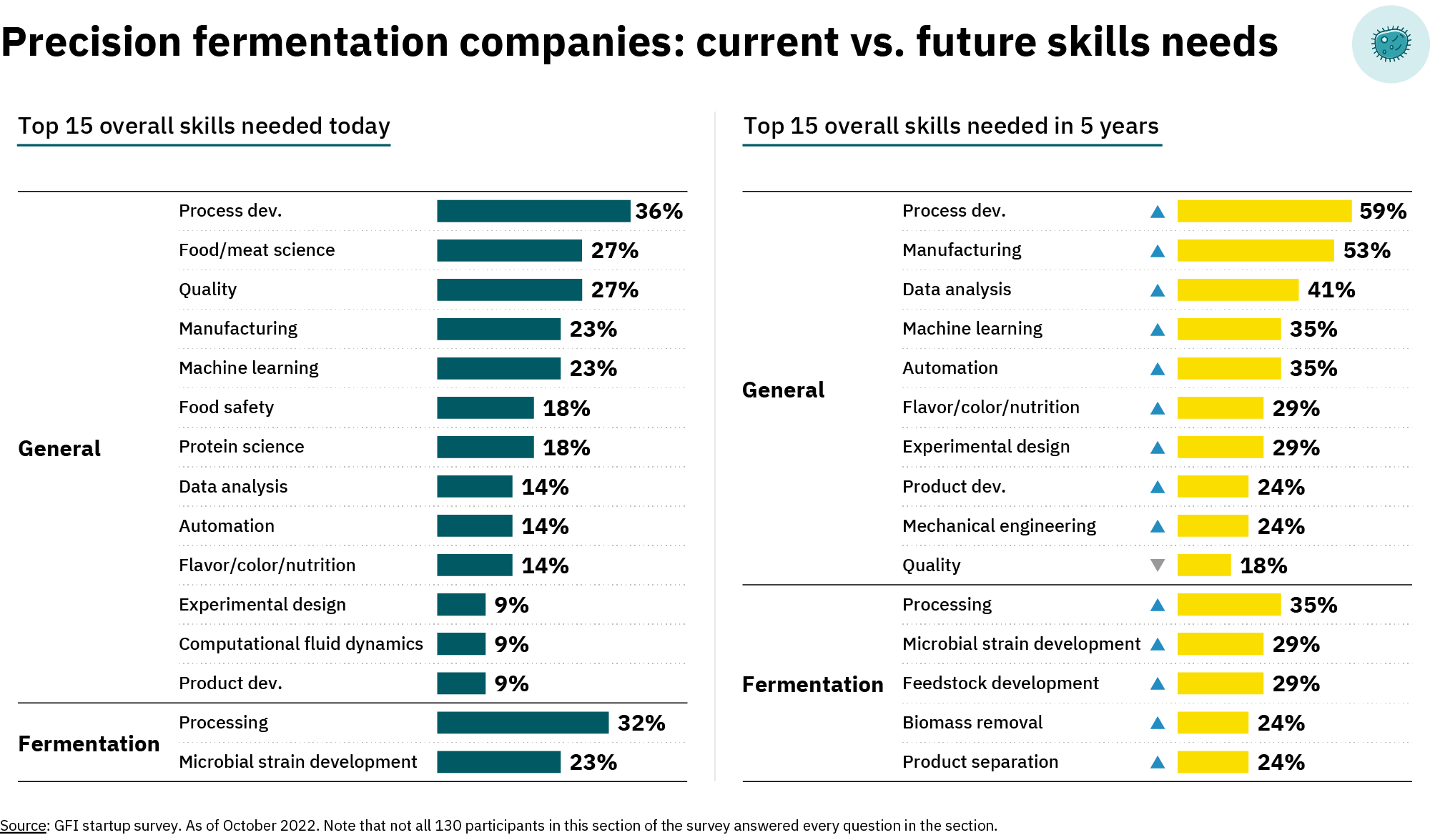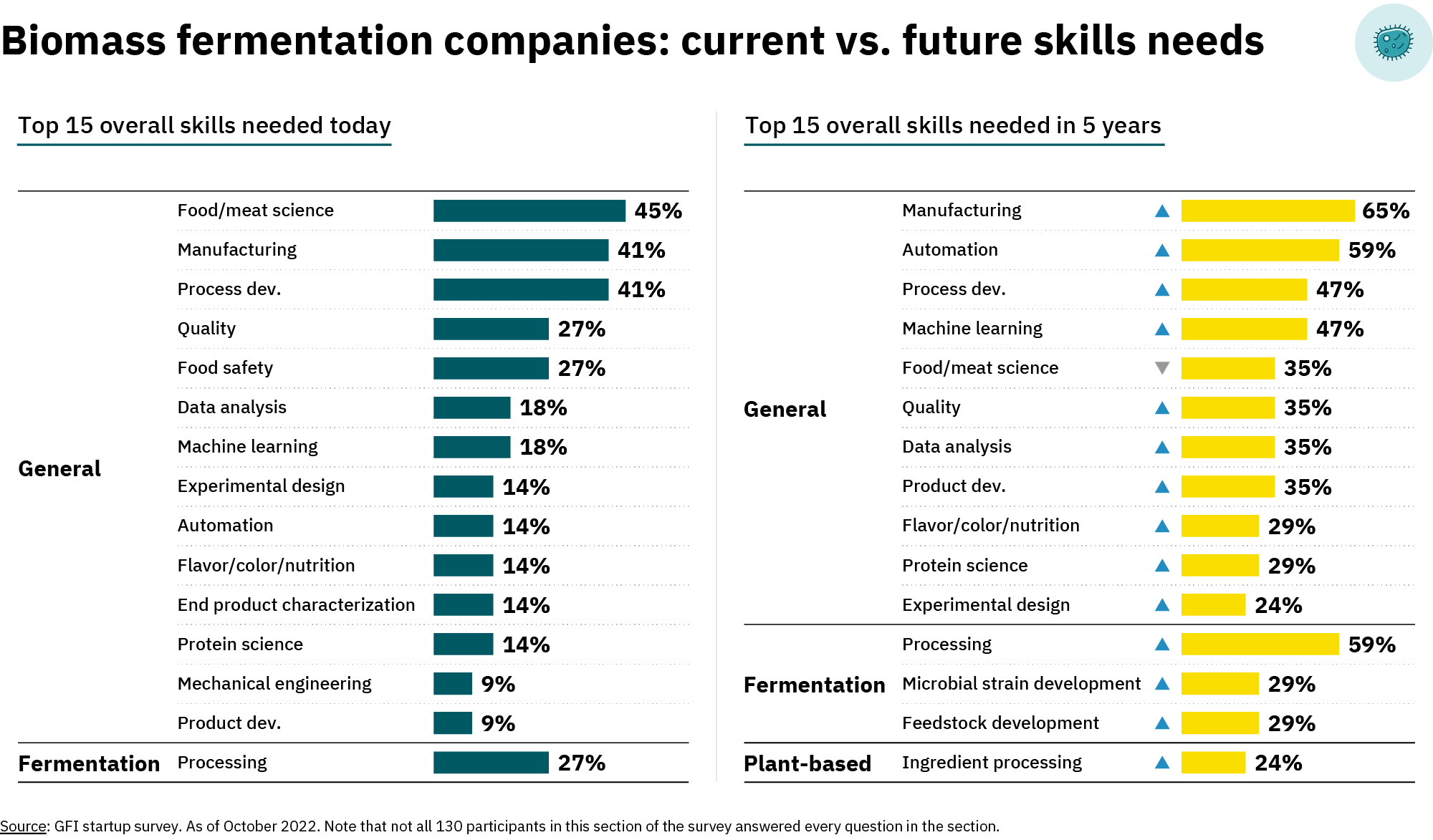Alternative protein startups underscore the need for scientific and engineering talent

Alternative proteins will be a cornerstone of the 21st-century green economy
Making meat without the animal is no easy feat. In order to successfully build a new technological paradigm for feeding a growing global population, we’ll need the people power to propel plant-based, cultivated, and fermentation technologies forward: highly-specialized scientists and engineers, and lots of them.
Recent months have seen some alternative protein startups paring back their workforce amidst uncertain economic conditions and global market downturns, along with their legacy counterparts from the food industry and beyond. However, we remain optimistic that alternative proteins are well-poised to drive economic growth and job creation into the future.
According to a 2023 Global Innovation Needs Assessment by Climateworks Foundation and the Global Methane Hub suggests that the alternative protein industry could generate up to 83 million jobs by 2050.
Its ability to do so will largely be dependent on the amount of public and private investment dollars that pour into research and development, physical infrastructure, and workforce development programs.
Though the sector is still in its nascency, we’re beginning to see promising signals of its potential to trigger widespread economic growth
There are nearly 2000 specialized and diversified alternative protein companies across the value chain creating thousands of new jobs around the globe. Governments are beginning to seize the alternative protein opportunity with landmark investments in research and training.
Leading institutions like Tufts and the Technion have established research and training hubs to nurture the next generation of alternative protein talent. Since 2020, the alternative protein sector has raked in $11.2 billion dollars of capital. However, a new GFI analysis unveils that demand for alternative protein talent continues to outpace its supply.
Late last year, we surveyed our global community of alternative protein startups on their workforce development needs. We received 130 responses*, with representation from North America, South America, Europe, Asia, Australia, and Africa. 53% of the respondents work on plant-based technologies; 34% cultivated; 20% precision fermentation; and 20% biomass fermentation; with 27% of respondents working across multiple production platforms.
The plurality (48%) of respondents were from startups with between one and four employees, which means our data is heavily weighted toward the needs of early-stage startups. Read on below for our key findings and recommendations.
*Not all 130 respondents responded to every question.
Scientific and engineering talent is greatly needed
While the alternative protein sector has been steadily growing in the last decade, startups continue to feel pressed for sufficient technical talent to drive their technologies forward. 52% of respondents reported difficulty hiring technical talent and, among them, 94% viewed technical talent bottlenecks as posing “very severe” or “moderately severe” challenges to their organization’s long-term success.
Beneath the umbrella of technical talent, there is an especially significant need for an infusion of scientific and engineering talent to bolster the sector’s research and development capacity. Of those that reported difficulty hiring technical talent, 79% reported having difficulty hiring scientists and engineers for research and development roles, with 35% and 22% reporting difficulty hiring operators and technicians for manufacturing roles and quality assurance and control roles, respectively.
Consistent with other emerging technological fields, we expect the nature of talent needs to shift as the sector matures and increasingly transitions toward commercial-scale production when the plurality of the technical workforce will likely become manufacturing operators and technicians rather than benchtop scientists. This may already be true for startups at later stages of maturity than the ones most heavily represented in our survey data.

Cross-production platform skills are in the highest demand
When we asked alternative protein startups to select the top technical skills and backgrounds missing from their team today, we found that “general” or “cross-platform” skills and backgrounds appear to be most needed. Cross-platform skills include disciplines like food science and meat science, process development and scale-up, manufacturing, product development, and food safety, which have a wide range of applications across the spectrum of alternative protein technologies. When we asked companies to predict the top technical skills they anticipate needing most five years from now, skills related to manufacturing, process development, and scale-up, product development, and automation floated to the top.
The graph below illustrates the top 15 reported overall technical skills gaps of the alternative protein companies we surveyed, now and in five years. Example interpretation: “35% of respondents reported that food science or meat science is presently among their organization’s top 5 most needed technical skills and backgrounds.”
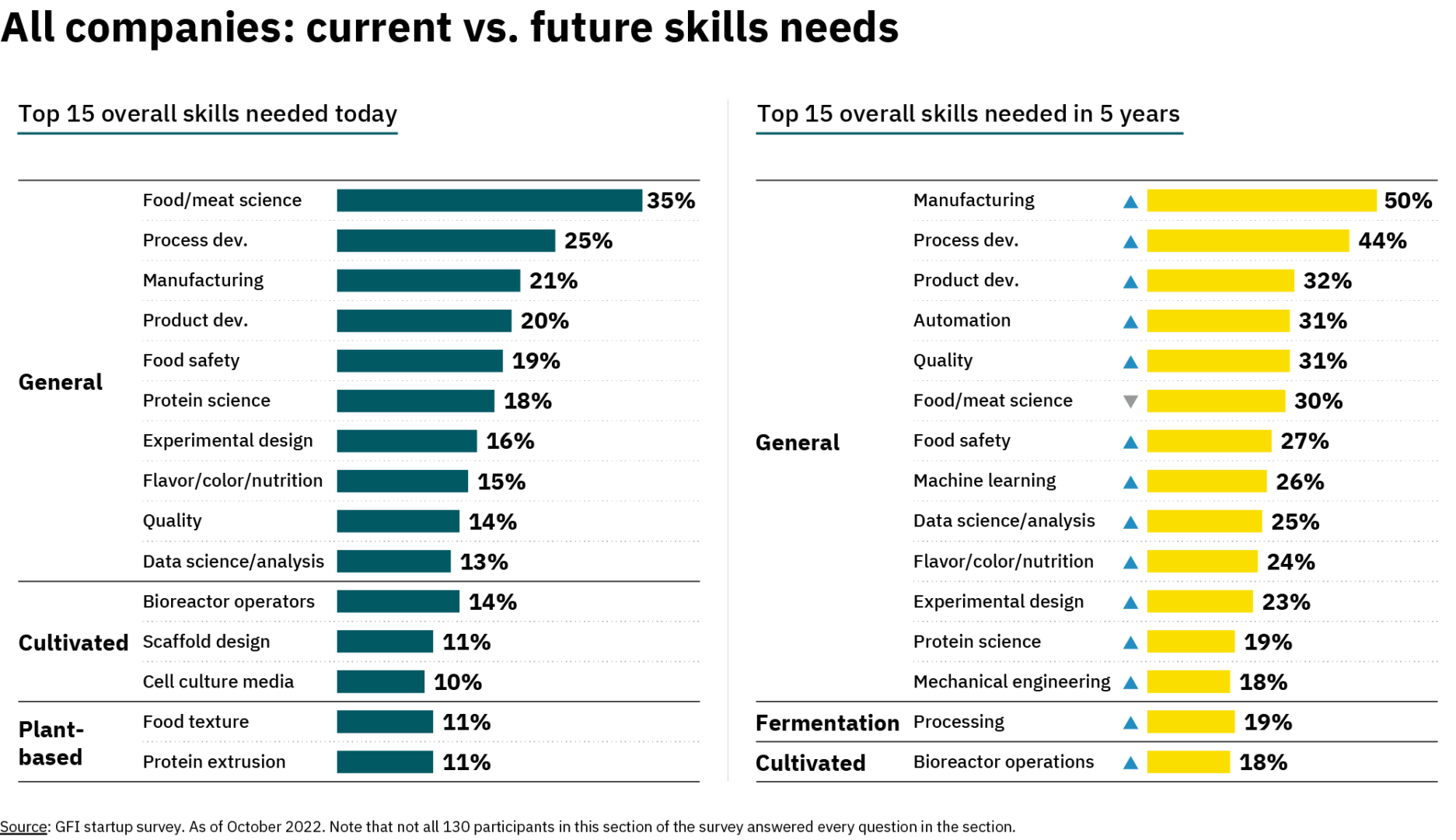
Specialized, platform-specific skills and backgrounds are also needed
Plant-based meat companies reported a need for more protein extrusion and food texture development experts for product development; cultivated meat companies reported a significant need for bioreactor operators and controllers, scaffolding design experts, cell culture media developers, cell line engineers, and tissue engineering experts to support research and scale-up across the value chain; precision and biomass fermentation companies highlighted a need for downstream process engineers to support scaling from lab and demo scale to commercial-scale production; and precision fermentation companies cited a need for microbial strain development capabilities.
The landscape of talent needs will be ever-evolving as the sector reaches new phases of maturity; however, alternative proteins will likely continue to be a vast, multidisciplinary undertaking requiring talent across the science and engineering continuum.
The charts below illustrate the top 10 most-needed skills of the companies we surveyed, now and in five years, organized by company type. Example interpretation: “40% of surveyed plant-based meat companies reported that food science or meat science is presently among their organization’s top 5 most needed technical skills and backgrounds.”
Alternative protein startups were presented with the following, non-exhaustive list of skills involved in alternative protein technologies from which to make their selection.
General
- Experimental design including DoE
- Data science and analysis
- Sequencing and bioinformatics
- Manufacturing
- Mechanical engineering
- Computational fluid dynamics
- Process development and scale-up
- Automation
- AI/machine learning
- Product development
- Food science or meat science
- Quality assurance and control (including cGMPs)
- Food safety
- Flavor, color, nutrition development
- Packaging
- End product characterization (rheology, L*a*b, TPA, etc.)
- Protein science
Plant-based
- Protein extrusion
- 3D food printing
- Food product design
- Food texture development
- Ingredient characterization
- Ingredient processing
- Lipid structuring
- Crop genotyping and breeding
Cultivated
- Cell culture (aseptic technique, cryopreservation, passaging)
- Cell line engineering
- Cell culture media development
- Metabolomics
- Flow cytometry
- Molecular biology techniques (PCR, Western Blot, cloning, etc)
- Tissue engineering
- Scaffold design
- Bioreactor operators and controllers
- Measurement techniques
Fermentation
- Aseptic technique
- Lipid extraction and fractionation
- Gas and liquid chromatography
- Biomass removal
- Product separation
- Microbe characterization
- Microbial strain development
- Feedstock development
- Downstream processing
Awareness, training, and geography present major challenges
When we asked startups what they perceive the central reason for these bottlenecks to be, 45% of respondents selected “lack of awareness,” indicating that people with the right skills exist but don’t know about opportunities in alternative proteins; 42% selected “lack of training,” meaning that there aren’t enough people with the right skills, education, and training to meet labor force needs; and 46% selected “geographical location,” signifying that people with the right skills exist, but they reside in a different location than the organization operates and are unable or unwilling to relocate.
While these kinds of workforce development obstacles may not be entirely unique to the alternative protein space, they present sizable challenges and opportunities for our sector.
On awareness
Universities and professional associations have a key role to play in ensuring that their members and students understand the rich tapestry of career opportunities that exist in our movement toward a cleaner, greener mode of meat production. Initiatives like the career pathways seminar series—where GFI, scientific pioneers, and professional associations like AOCS, BMES, and TERMIS partner to elucidate opportunities to apply technical training to the needs of the alternative protein field—help STEM professionals better understand how their existing skills can be meaningfully applied to the protein transition. Offices of career services should surface alternative protein job opportunities to their undergraduate and graduate student populations and incorporate alternative protein programming into existing career fairs and on-campus hiring programs. Student groups should form powerful bridges between talent-seeking alternative protein companies and the job-seeking student population.
On training
Similarly, education and training providers and workforce development organizations are critical for creating the sector-specific, industry-relevant training programs necessary for a robust alternative protein talent pipeline. Colleges, universities, and other academic entities should develop alternative protein courses and majors; incorporate alternative protein modules and lectures into existing courses about enabling technologies like tissue engineering, bioprocess development, crop optimization, and microbiology; and create grants and fellowships that allow interested researchers to specialize and gain hands-on work experience in alternative proteins. Universities should also harness their extension and outreach programs to reach non-traditional students or existing workforce professionals looking to gain new skills or switch career paths. Governments should fund workforce development programs that help individuals from the food, biotechnology, and manufacturing industries build skills around alternative proteins.
On geography
Many of the inputs for alternative protein products are grown in rural, agricultural areas, but food tech and biotech talent tends to emerge from urban centers. As a product of this dichotomy, robust, ready-made talent streams are unlikely to emerge organically where talent is most needed. To mitigate these geographical challenges, companies should proactively establish partnerships with academic institutions located near the heart of their manufacturing operations to co-develop training programs that will cultivate industry-relevant talent for their organizations. Governments should invest in the development of talent generation programs at universities that have strong preexisting food science and agricultural science programs to attract alternative protein innovators to the region and sow the seeds for new industrial hubs that will catalyze economic development.
Alternative protein startups are eager to partner with institutions of higher education to close workforce training gaps
The alternative protein startups we surveyed signal a healthy appetite for partnering with academic institutions to bridge labor force gaps. Participating startups were most interested in working with universities, independent research institutes, and technical colleges and trade schools. They were especially eager to partner with these institutions on research projects, centers, and consortia; developing internship programs and promoting existing internship opportunities; providing guest lectures for relevant courses; and participating in career fairs and on-campus hiring programs.
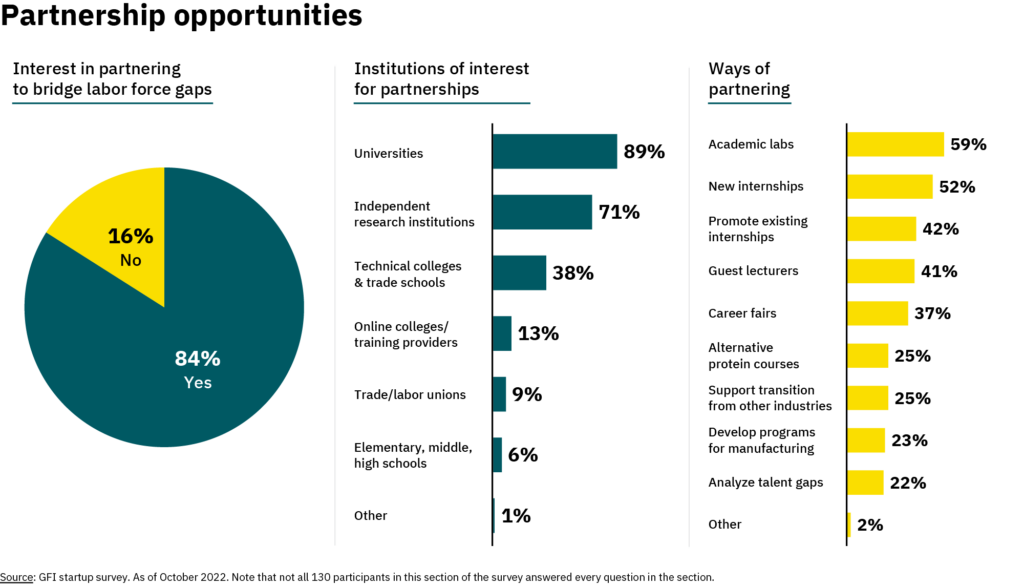
An abundance of opportunity
The alternative protein field holds a lot of promise for building a more sustainable, secure, and just protein supply. However, it is still in its early stages, with many foundational R&D questions to resolve and critical capacity to build.
We encourage universities, professional associations, and policymakers interested in helping pave the way for a brighter protein supply to reach out.
These conditions present an abundance of opportunity for scientists and engineers looking to make their mark, and a bounty of economic development potential for governments interested in bolstering regional competitiveness.

Page
Contact
Have a question on alternative proteins? GFI’s experts are here to help. Contact us.
